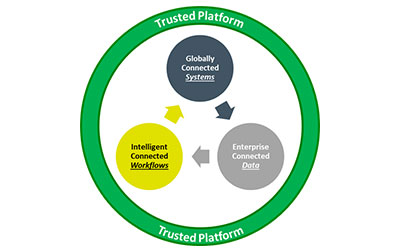Driving innovation through disruptive technology

Emerging technologies are beginning to shape the execution of our engagements as well as our clients’ assets, and we must examine the new technology’s potential in four parts to understand how it relates to project delivery: the strategy, the design cycle, the processes, and behaviors that hinder its success. With these components in place, the adoption of emerging technologies enables an agile Digital Project Delivery (DPD) life cycle that keeps pace with innovation.
The strategy: Data, systems, and workflows
A data-driven culture is determined by three main tenets that form its core foundation: globally connected systems, which allow the industry to be effective and efficient in our operations; enterprise-connected data, which allows for a single source of truth with hyper-connectivity to global applications and sources; and intelligent, connected workflows, which emphasize the automation of activities and repetitive tasks, as well as the importance of knowledgeable teams.
By setting the stage and harnessing strategic value this way, we see an industry shift away from siloed data and toward integrated data to create an inter-connected platform that simultaneously answers the questions: What happened in the past? What are ALL the things happening now? And what is likely to happen next?
By answering what is likely to happen next? We can form mature, well-connected organizations that rely heavily on its decision-making process on advanced data analytics. This enhanced decision-making process can predict potential challenges and prescribe corrective actions, forming an inter-connected platform that sets the stage for the design cycle of digital project delivery.
The technology design cycle
From 2018 to 2022, the industry focused heavily on developing a core integrated project delivery system. The next technology development cycle, from 2023 to 2027, will focus on harvesting the tremendous amount of data we’re creating as part of our project execution. And integrated systems do not work alone; we need to harness and interpret the data created by these systems to determine the benefits and risks in applying disruptive technologies to our digital project delivery process.
When organizations harness collective project data, extensive data are required to make an informed decision and use preliminary findings as building blocks. Common bricks of knowledge can be applied across multiple business sectors, clients, and projects, and help form integrated decisions and thought processes.
Enhancing the decision-making processes this way will rely heavily on building state-of-the-art data models coupled with advanced Machine Learning (ML) and Generative Artificial Intelligence (Gen AI) tools.
The processes
Generative AI (Gen AI) is an important and disruptive technology. Gen AI refers to the creation of new data, patterns, etc. that can perform tasks typically requiring human intelligence. We can look at the foundation of Gen AI as a way of generating the common blocks—or tools and data—that can serve at a cross-sector level. When data is harnessed digitally, it becomes easier and more functional to apply it across our business and engagement life cycle from the proposal phase to commissioning across all business units and sectors.
Within digital project delivery, Gen AI and automation technology innovations can impact design engineering. The automation of work processes and the use of data-centric design aided by Gen AI technologies can result in the creation of machine-based design recommendations in areas such as design engineering, procurement, construction, and quality.
Regardless of sector, by enabling the prediction of project outcomes, we see patterns and commonalities emerge across projects. Once this data is extrapolated and reused, operations become more efficient and effective.
The continuous improvement begins during the proposal stage. With the ability to pull from a common data environment, much of the information for a sound proposal is already available, and delivery teams can harness this data and improve their bid. Essentially, an information loop closes through connected data in order to be improve efficiency.
The adoption of these emerging technologies
People don’t change in a natural way; we tend to fight what we don’t understand. In order to successfully transition to the new digital generation, people have to adapt, and to do this, organizations need to equip delivery teams with two advantages: a familiarity of the new systems and processes, and the capability to implement them. When we have knowledgeable teams that communicate, address risk early, and continue to evolve their skills, positive change happens. When teams understand the value of the change and how to execute it, cultural transformation can happen.
What’s next?
Throughout the last five years, systems and processes have evolved to innovate and understand disruptive technologies, and looking ahead, the next five years will be just as exciting.
We’re witnessing the rebirth of a very promising technology: Artificial Intelligence (AI). With the ability to process more and more data, the AI revolution is coming faster than anticipated.
Companies are at a major technology crossroads where “Generative AI” will play a major role in their existence and their growth as a business. They must adapt their strategy and make the necessary changes to their business model not only to survive, but to compete in this new world.
At Hatch, we’re transforming our delivery and business systems, ultimately becoming a digitally mature organization where decision making will be heavily based on data—the digital backbone of our organization. Our digital culture is propelling us toward a solid digital foundation by equipping our delivery teams with the knowledge and skills necessary to drive efficiency and project delivery into the next generation. To learn more, visit Digital Project Delivery (DPD).

Maurice Tayeh
Global CIO at Hatch
Maurice is the Global CIO at Hatch, spearheading digital transformation with a focus on the transformative Digital Project Delivery initiative. His journey began in aerospace, mastering AI and robotics. He later held Global CIO roles in international and Fortune 500 companies, driving innovation through strategic tech decisions. Beyond his career, Maurice, a multilingual global citizen fluent in English, French, and Arabic, has lived and worked across continents, enriching his leadership with cross-cultural expertise, and fostering global innovation.